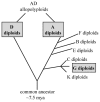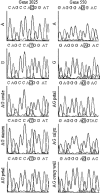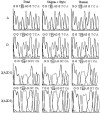Organ-specific silencing of duplicated genes in a newly synthesized cotton allotetraploid
- PMID: 15371349
- PMCID: PMC1448729
- DOI: 10.1534/genetics.104.033522
Organ-specific silencing of duplicated genes in a newly synthesized cotton allotetraploid
Abstract
Most eukaryotes have undergone genome doubling at least once during their evolutionary history. Hybridization followed by genome doubling (allopolyploidization) is a prominent mode of speciation in plants, leading to phenotypic novelty and changes in genome structure and gene expression. Molecular events that take place immediately after polyploid formation can be studied using newly synthesized allopolyploids. Here we studied the extent of gene silencing in a newly created and genomically stable allotetraploid cotton, of genotype AAGG, using an AFLP-cDNA display screen. Over 2000 transcripts were screened and approximately 5% of the duplicated genes in the allotetraploid were inferred to have been silenced or downregulated. Sequencing of 24 AFLP-cDNA fragments revealed genes with a variety of functions. Analysis by RT-PCR showed silencing or a strong expression bias toward one copy for 9 of 13 genes examined. Comparisons of expression patterns among eight organs in the allopolyploid showed that silencing and preferential expression are organ specific. Examination of silencing patterns in two other synthetic polyploids, of genotype AADD, showed that the same gene can be silenced independently in different genotypes. These results provide a detailed portrayal of gene silencing events that can occur following allopolyploidization and suggest epigenetic causal factors.
Figures




References
-
- Adams, K. L., and J. F. Wendel, 2004. Exploring the genomic mysteries of polyploidy in cotton. Biol. J. Linn. Soc. 82: 573–582.
-
- Beasley, J. O., 1940. The origin of American tetraploid Gossypium species. Am. Nat. 74: 285–286.
Publication types
MeSH terms
Associated data
- Actions
- Actions
- Actions
- Actions
- Actions
- Actions
- Actions
- Actions
- Actions
- Actions
- Actions
- Actions
- Actions
- Actions
- Actions
- Actions
- Actions
- Actions
- Actions
- Actions
LinkOut - more resources
Full Text Sources
Other Literature Sources

